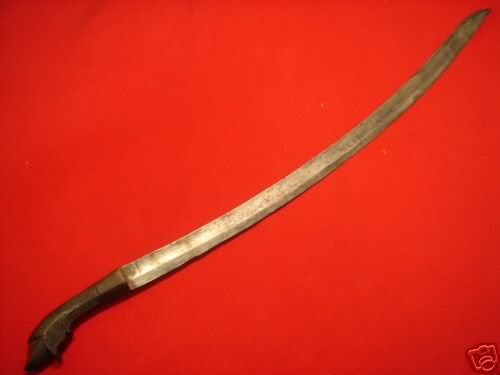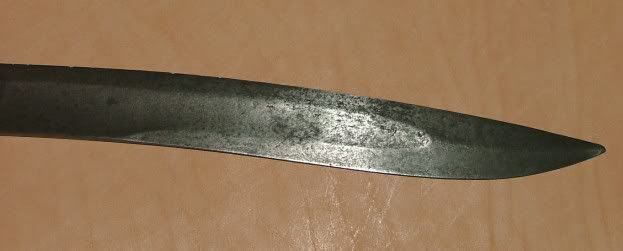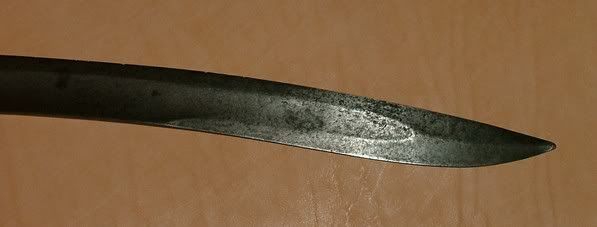
 |
|
|
#1 |
|
Member
Join Date: Dec 2004
Location: Sweden
Posts: 1,637
|
Not sure what this sword is but maybe some of the other forumites have any clues?
It's however not a Latok as described. I haven't been able to find neither the hilt nor blade in any reference litterature. Could it be any of the Batak tribes close to Aceh? Or Visayan? http://cgi.ebay.com/ws/eBayISAPI.dll...MEDW%3AIT&rd=1 Michael Last edited by VVV; 15th December 2005 at 01:31 PM. |
|
|

|
|
|
#2 |
|
Vikingsword Staff
Join Date: Dec 2004
Location: The Aussie Bush
Posts: 4,361
|
Michael:
I was following that one too and don't recognize it as an established sword style. Even managed to get in a bid that fell way short. I don't know where it's from but the blade struck me as a modified European saber. The hilt seems to show some Sumatran/Aceh influence, while the terminal "bud" does look a little Visayan. Maybe a custom assembly for a European living in Sumatra.  Ian. |
|
|

|
|
|
#3 |
|
Member
Join Date: Apr 2005
Posts: 3,255
|
My condolences to all fellow bidders...
 I'm stumped, too. Some Parang Nabur blades are similar but I can't recall a similarly extensive fuller. I was thinking more of a Ladieng without the usual broadened tip. The light construction seems to suggest a fighting piece rather than a tool and I hoped the obscure hilt would help to pin down the origin of this beast eventually. I'm not sure about the blade - a decent etching might reveal more about the forging process. However, is it possible to grind this tip shape out of an European blade without getting a very thin tip where the fuller would pass, Ian? Regards, Kai |
|
|

|
|
|
#4 |
|
Member
Join Date: Dec 2004
Location: Sweden
Posts: 1,637
|
Ian and Kai,
Thanks for your interesting comments. Ian, the idea of a rehilted European saber is interesting. Either made for a European or captured/traded by f.i. a Batak who made some personal modifications regarding the hilt. The hilt is confusing. Very much like a Rudus hilt on the grip but the top part doesn't fit in. Kai, I also first thought of a Ladieng until I looked closer to the Seller's pictures. On the Nabur I agree on the fuller as well as they are not as slender as this blade. Michael |
|
|

|
|
|
#5 | |
|
Member
Join Date: Apr 2005
Posts: 3,255
|
Hi Michael,
Quote:
Regards, Kai |
|
|
|

|
|
|
#6 | |
|
Vikingsword Staff
Join Date: Dec 2004
Location: The Aussie Bush
Posts: 4,361
|
Quote:
I don't know, Kai, but that whole tip area looks heavily pitted which suggested to me that it may have been "reworked." The amount of wear there is disproportionate to the rest of the blade. Perhaps others might be able to answer that question. I suppose it would depend how long the original saber was, and how much it may have been shortened, as to how thin the fuller may have been. Interesting sword. Ian. |
|
|
|

|
|
|
#7 |
|
Member
Join Date: Feb 2005
Location: Chicago area
Posts: 327
|
Agree with Kai and the examples cited. May have been originally doubled edged towards the blade tip or modified for definitive warfare; used like the panabas as a clean-up.
|
|
|

|
|
|
#8 |
|
Member
Join Date: Dec 2004
Location: Sweden
Posts: 1,637
|
Kai,
I retract my earlier comment on the slender blade. I have one resembling pict 388 - that's even a bit longer - and of course the XXL ones have a more slender blade than the "regular" or very short Naburs. Thanks also for commenting on the bud. I don't have any of this variation but have handled 390 IRL and "almost" got one at Herman Historica last Spring (Auction 48 - lot 2813 if you want an additional reference picture than the one in van Z). I forgot about it because it's quite rare. On pict 389 I am a bit sceptical to if it should be called a Parang Nabur if it doesn't have the D-guard, but that's another discussion... Thanks for all input! Michael |
|
|

|
|
|
#9 |
|
Member
Join Date: Dec 2004
Location: Virginia
Posts: 520
|
Just my thoughts. The blade on here strongly reminds me of the blades on Aceh peudeueng peusangan( aka sikin peusangan, sikin pasagan ). Compare these two
  Of course the handle is very different. I would like to hear if others see the resemblance in the blade or not The hilt does have some resemblance to a hulu tapa guda. You can see on on D. Buttins site here : http://old.blades.free.fr/pics/picsw...ang/kle03p.jpg And the tulip bud is a common motif in Aceh art, many of the other carvings shown also resemble motifs and designs seen in "Hands of Time - Crafts of Aceh" by Barbara Leigh. Of course there are many other places in the region that use similar designs. That being said I think there is a strong case to be made for it being an Aceh sword Last edited by RhysMichael; 15th December 2005 at 05:56 PM. |
|
|

|
|
|
#10 |
|
Member
Join Date: Dec 2004
Location: Sweden
Posts: 1,637
|
Thanks RhysMichael,
Very resembling blade. So back again to Aceh origin... Michael |
|
|

|
|
|
#11 | |||||
|
Member
Join Date: Apr 2005
Posts: 3,255
|
Thanks for the reminder, John!
http://home.comcast.net/~jtcrosby/Aceh.html  Quote:
Quote:
Quote:
Quote:
Quote:
Regards, Kai |
|||||
|
|

|
|
|
#12 | |
|
Member
Join Date: Dec 2004
Location: Virginia
Posts: 520
|
Quote:
|
|
|
|

|
|
|
#13 |
|
Vikingsword Staff
Join Date: Dec 2004
Location: The Aussie Bush
Posts: 4,361
|
John:
Agree. Those blades look very similar. Appears to be a distinct type of sword that is very uncommon. The"bud" at the end of the hilt -- could that be a lotus flower? If so, does that give a clue to which tribal group might have such a motif? I don't recall a lotus symbol being used widely in Isalmic art. More likely Buddhist, but then that does not fit well with Sumatra. Interesting. Ian |
|
|

|
|
|
#14 | |
|
Member
Join Date: Dec 2004
Location: Virginia
Posts: 520
|
Quote:
Hindu and Buddist influences were noted to be in Aceh as early as the first century AD. From what I can find there is still a great deal of this seen in their arts and crafts. Several things about that and the design fit with this. Barbara Leigh describes the motifs falling into 5 categories:geometric, vegetable life, bird life, other faunal life and islamic motifs. The casusarona seed, lotus , and bamboo playing prominant roles in the vegetative motifs. The way the designs are separated by border into the separate motifs also fit in with what has been called "a grammer of design", is a characteristic in Indonesian art. Thats a great thought about the style pinning it down to a certain tribal group. That may take someone on the ground there to find out. I do not know of any references that would give us this information. But I have found few that give much specific information on these swords. Here are the pictures of the sword tip. The blade is positioned edge up false edge down.   As to this syle of blade here is one that Therion used to have I do not know if he still does http://www.therionarms.com/pictures/sikkin.jpg This one is in the KIT, in Holland http://img32.photobucket.com/albums/...peudeueng1.bmp Again to whoever got this sword congratualtions on a good sword at a very good price. I would have gone much above this if it was not Christmas and all my funds tied up for that. Last edited by RhysMichael; 17th December 2005 at 11:09 PM. |
|
|
|

|
|
|
#15 | |
|
Member
Join Date: Nov 2004
Location: USA
Posts: 1,725
|
Quote:

|
|
|
|

|
 |
| Thread Tools | Search this Thread |
| Display Modes | |
|
|